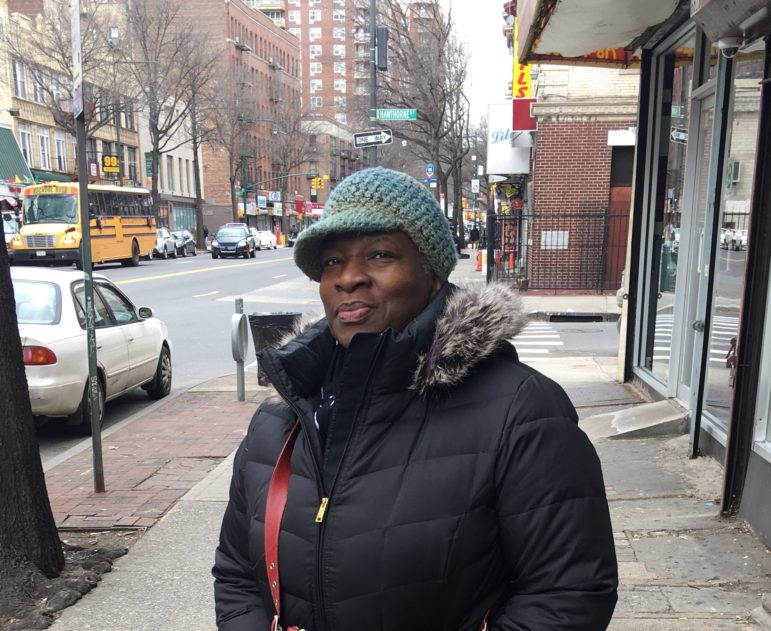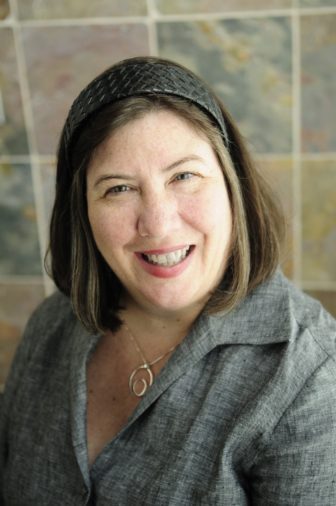
Daniel Bates
Brenda Edwards-Gueye and her allies did not win their fight against a proposed development in Brooklyn. But she believes bonds were formed that will serve the community well in the next battle.
This story is the last in a five-part series about displacement and the advocates who are battling it around the world.
* * * *
Gentrification is far from a new issue in New York. The city adopted emergency rent laws in 1920 and the rent control program began in 1943, making it the longest running in the United States. The debates taking place at that time bear a startling resemblance to those underway now: They involved a housing shortage and the prospect of landlords raising rents too high too fast.
Compared to some of the other cities in this project on global gentrification, the resistance against it here is far more established, so City Limits spoke to people who have been involved in the fight for many years. The chief lesson they have learned is that old-fashioned community organizing and coalition building is the best way to get things done. Elected officials won’t listen to experts, no matter how well-informed they are, but if a busload of voters turn up on the doorstep, they will pay attention.
Another key lesson is that activists have to think big and consider change across the city, not just in their neighborhood. The consensus was that the best-long term solution is either a nonprofit group or a housing association using innovative financing and buying the land as well as the buildings.
These lessons and many more emerged from discussions with six community activists, developers and experts, all of whom have worked on gentrification and affordable housing for many years.
Lesson #1: Defeats Sow Seeds for Successes
Brenda Edwards-Gueye is a community activist in Prospect Lefferts Gardens, a neighborhood of Brooklyn where she has lived for the past 19 years. The retired teacher became active in her community in 2011 with the development of the Parkline, a 23-story tower built on her street, blocking out the sunlight for her and many other residents. Despite protests including activists barricading themselves in front of the building, the developer made few concessions apart from their already promised 20 per cent affordable units, the other 80 per cent being market rate.
What was especially galling for people like Edwards-Gueye was that The Parkline seemed like a slice of Manhattan real estate that had landed in a working-class, largely African American neighborhood in Brooklyn. Architecturally it was not in keeping with the area and the only building of a comparable height nearby was a hospital. When the Parkline opened in 2016, rents started at $2,123 for a two-bedroom apartment and $4,430 for three-bedroom apartments, putting it far beyond the reach of most in an area where median income is $39,000. It also had luxury amenities like a doorman and a “Sky Kitchen'”—a private dining area on the roof for residents to host parties.
Edwards-Gueye says that during the development of the Parkline, a coalition of community groups tried everything they could including organizing a meeting with New York City councilmembers and their state senator. One meeting in a church drew 500 people; some couldn’t even get in the building.

In a surprising victory, the protesters managed to get a temporary restraining order from a judge in June 2014. But the following summer work resumed and the building reached its full height soon after.
On the face of it, the protests were a failure, but Edwards-Gueye does not see it that way and she continues to be involved in the community, albeit through different groups.
“The success is how many people found out about what is going on in their neighborhood,” Edwards-Gueye says. “People started asking us what was going on and became more interested in what’s going on in local government. That’s super. For the next round—and there will be a next round—they will have their eyes open. The awareness is what I’m talking about.”
Lesson 2: Don’t Simply Play Defense
Ava Farkas is executive director of the Met Council on Housing, an advocacy group for tenants in New York that has been operating for more than 50 years. She grew up in the Bronx and has been organizing for more than a decade.
One of her longest running projects involved the redevelopment of the Kingsbridge Armory in The Bronx, a castle-like structure which occupies an entire city block. It was built in 1912 and was originally used to store munitions; developers wanted to turn it into a shopping mall.
To stop the Armory from being developed against community wishes, Farkas helped build a “huge coalition” with a lot of help from local churches and labor unions. The group wrote up a list of principles onto which they persuaded politicians and interested parties to sign. A crucial intervention was from the Bronx Borough President Ruben Diaz, Jr. who came out against the shopping mall and turned it into a populist campaign against what he called “profits for barons.” In 2009. the City Council rejected the proposed development.

Ava Farkas
The Council ultimately adopted a proposal to turn the site into a $350 million ice skating rink, the largest in America. While construction of that rink has been delayed, Farkas and her colleagues were able to get the developers to agree to a landmark community benefits agreement with provisions on local hiring, green building, community use of the facility and more.
A key factor in achieving that, she says, “was that the community was on the offense.”
“We weren’t reacting to the city’s plans, we were the ones who got the city to embark on the project of redevelopment.”
Farkas says that the coalition of groups she worked with thought a lot about who would monitor the agreements they won from elected officials after they were no longer personally involved.
“You have to have institutions that are longstanding community institutions to really be able to [make sure] the commitments that they make are carried out. It’s hard for individual community members to give that level of involvement for so many years consecutively so you need an institution that is going to constantly keep reorganizing people around the issue and keep agitating people to hold corporations accountable, and it’s very hard work.”
Another lesson is that advocates have to be invested in the long haul. The armory, after all, has been a topic of contention for more than two decades.
“One of the things I’ve learned is all change is on such a long timeline. I have a much more realistic view about how long it takes to make change,” Farkas says. “That’s what those in power have over the rest of us: They have the money and the time to make plans 20, 30 years ahead. That’s how they see their visions for the city happen.”
Lesson 3: Own the land, chart the future

Daniel Bates
Walter Edwards
Walter Edwards is a housing developer based in Harlem and the chairman of the Harlem Business Alliance, a group of local business owners. His projects have included the Kalahari Condominium, two 12-story apartment blocks made up of 259 mixed-income homes.
Edwards, who is African American, is proud of the site’s African name and the striking work on the outside of the building that was inspired by sub-Saharan tribes. But he is scathing about the unchecked development in Harlem, America’s black cultural capital. As Edwards sees it, the culture of Harlem is “slipping away” and visitors who come to the neighborhood are disappointed they cannot find what they expected to see.
During the 1980s, New York City owned about 60 per cent of Harlem because the neighborhood was in such bad shape. But in Edwards’ view, it has swung too far in the opposite direction after decades of gentrification by developers with far bigger pockets than his development company, Full Spectrum.
“They looked at making money off real estate and they didn’t care anything about the culture. I came to Harlem when I was nine years of age. It was an up-and-coming community that people took pride in. There was some type of organization almost at every block that was looking to better conditions for our people,” he says. “Slowly but surely they knocked those leaders out and you don’t see that anymore. You don’t have that energy anymore.”
“The drums used to play here but the investors came and said, ‘They annoy us, so they chased the drums away. There’s no block parties any more. People who used to own brownstones side by side and would sit out playing checkers on the stoop, cards—you don’t see them anymore. They chased them out and made the communities ‘safe.'”
Edwards’ answer to the problem is simple, if challenging to execute: :The only way to resist it is to own the land. It’s the same thing that has been happening since the beginning of time. He who controls the land, he controls what happens.”
Edwards had a bleak vision for the future of development in Harlem. “There’s very little left that you can do now. Air rights are so expensive. They’ve priced everyone out of the market. I think there can be valuable lessons learned from Harlem and what has happened to Harlem. Does it have to change so drastically? That’s the thing. If we can protect the property, we can make a big difference.”
Lesson #4: Organize, organize, organize
Speaking to Mary Dailey is like getting a history lesson on the past 40 years of New York’s working-class rental housing. She has spent her lifetime tackling issues around fair housing and gentrification and has a deep knowledge of the history of gentrification in New York. Dailey is currently a consultant at the Met Council on Housing and for 10 years prior to that she was lead organizer at the Center for Community Change, a national organization devoted to tackling economic injustice.
She recalls the early 2000s, when New York City created a program of voluntary inclusionary zoning—where a developer could get a zoning bonus and create a larger building if he agreed to include affordable apartments. The program proved very ineffective.

Daniel Bates
Mary Dailey
“We were all still thinking too small,” she says. “We didn’t realize the degree to which the international economy was changing so that so much money from other nations could come into New York. The degree to which we would have not only the super-rich coming in to buy apartments, but Russian money and other money owning run-down apartment buildings. I think people underestimated the degree to which the rent-stabilized housing would fall to market pressure and the degree to which, neighborhood by neighborhood, this city would get hotter.”
For successful activism you have to have what Dailey calls the “impacted base,” or people who are directly affected by the changes happening around you. She believes that the basics of organizing have gone out of fashion and that groups have to choose leaders who have a base to draw on, are courageous, take risks and speak plainly and clearly.
Dailey also sees the lack of ethnic diversity in her field as a major problem that has gone on for years.
She says: “More and more analysis and framing of racial injustice is really key. It’s been a big failing.”
Lesson #5: Follow the Money
Celia Weaver is research and policy director at New York Communities for Change, a nonprofit group with eight chapters in neighborhoods in New York City and Long Island. NYCC is mostly made up of longterm community members who work on a range of issues including gentrification and housing education.
Weaver’s biggest fights are over the state’s rent-stabilization laws. Weaver’s group is always looking to close loopholes and ensure tenants have the right to renew their lease at a reasonable rate. Landlords usually want to weaken the laws in some way.
From Weaver’s experience, the best way to get things done is when “regular people come together and fight for it.” Echoing Dailey, she says the best people to protest are those who are “directly impacted” by the policies because they have a direct stake in it; phoning, emailing and calling your elected representative does work to an extent. “Politicians respond to their constituents. As much as they’re working for the real-estate lobby, they ultimately have to work for their voters or get voted out.”
The best strategy and policy tools that you can possibly come up with are the ones that really shift power from landlords to tenants. The reason we’ve found rent regulation and rent control to be effective is that it undercuts the business model that allows gentrification to thrive. Individual solutions like getting everybody a lawyer is not going to work if the laws are not good enough to protect the tenants that are there. We are organizing people for a much bolder shift in the existing framework.”

Daniel Bates
Celia Weaver
Her advice for people in less developed countries where gentrification is becoming an issue is to do your homework on who your opponents are. “Gentrification is happening because people at the top want to make money by extracting it from already divested communities so following the money is the most important thing.” Weaver says that activists should be “following the money to understand who is profiting and why and what is the structure that’s allowing them to profit and who is enabling those groups to profit. That’s how you’re going to find the best strategy to fight gentrification.”
Lesson 6: Use the power you have
Joan Byron is an architect and veteran activist who was involved with the Pratt Center for Community Development for 40 years, one of the oldest sustainable housing groups in New York. Over an hour long conversation at a cafe in Brooklyn, Byron—now the program director at the Neighborhoods First Fund for Community Based Planning (a funder of City Limits)—set out what she thought was her idea of success and how to resist gentrification.
“I would define success as defining power for the groups which are most disadvantaged by what’s happening,” she says. “Fundamentally it’s an imbalance of power that’s creating this situation and the three most effective ways to fight that are organizing, organizing and organizing. I say that not in jest because people know what they need. Allies can help folks to sharpen their strategies and figure out where the most effective opportunities and points of leverage are.” It’s not easy to form effective coalitions among elites with policy expertise and residents from the affected neighborhoods, but it can be done, she says.
But the biggest lesson Byron relates is that despite the power dynamics between the mayor or developers and community members, grassroots organizations do have leverage.
“Communities can hold the administration to its word. ‘You’re our friend, you’re progressive, you support affordable housing and fighting displacement – prove it. We have this specific action that we demand that you take, or demand that you not take and this is going to be the proof in this instance of whether you’re for real or in the pocket of this real estate industry.’ So that’s one of the ways that organizing is powerful in a way that respectable advocacy sometimes isn’t.”
One success that Byron has fought for and won was a requirement for particular landlords to provide a certificate of no harassment, which makes the awarding of building permits contingent on a showing that no tenants have been harassed over the previous three years. The burden of proof is on the landlord.
Another victory has been the creation of a right to counsel in housing court which ensures a level playing field against landlords and developers, who usually have their own counsel.
In countries where the process of gentrification is newer, Byron says, “There is a moment of opportunity for organizing supported by popular education to really change the dynamic in the future and to have the political power that people, when they organize in large numbers, can wield.”
The struggle to maintain a foothold in the city for the working class is not an easy fight. But it does have its rewards. “We could just as well be talking about policing, environmental justice and education. The thing about many of the solutions that apply to housing is, those wins stay won,” Byron says. “You build something, it stays built.”

Daniel Bates
Joan Byron









3 thoughts on “The Lessons NYC Activists Have for Those Fighting Displacement the World Over”
Pingback: The Lessons NYC Activists Have for Those Fighting Displacement the World Over - The Course Correction
Interesting that the Armory is mentioned, an example of community opposition that led to a counter productive end. The Armory is still vacant, and not producing any value to anyone aside from an aesthetic appeal. The vacant space inside stands as a great metaphor for the dissenting opinion to developing this site; attractive at first glance but lacking in substance.
Local government lost out on sales taxes, real estate taxes, payroll taxes, income taxes, Social Security and Medicare Taxes. Economic activity in the neighborhood was squashed for what end? To fight “profits for barons”? Profit from economic activity is eclipsed by the salary of those employed and by the cost of goods sold which are purchased from other businesses.
An entire ecosystem of Bronx businesses and employees could have thrived at the Armory. Instead it remains empty and without a meaningful place in the neighborhood. It’s nice to look at from outside though.
Thanks for this piece and the series, but an important correction – it was grassroots organizations like CASA, Community Voices Heard, Cypress Hills LDC, along with their technical assistance allies, who fought for and won Right to Counsel, Certificate of No Harassment, and more. Neighborhoods First is proud to have helped support that work, but credit for the victories belongs to those who actually waged the fight!